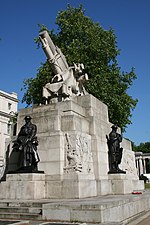The Royal Artillery Memorial is a First World War memorial located on Hyde Park Corner in London, England. Designed by Charles Sargeant Jagger, with architectural work by Lionel Pearson, and unveiled in 1925, the memorial commemorates the 49,076 soldiers from the Royal Artillery killed in the First World War. The static nature of the conflict, particularly on the Western Front, meant that artillery played a major role in the war, though physical reminders of the fighting were often avoided in the years after the war. The Royal Artillery War Commemoration Fund (RAWCF) was formed in 1918 to preside over the regiment's commemorations, aware of some dissatisfaction with memorials to previous wars. The RAWCF approached several eminent architects but its insistence on a visual representation of artillery meant that none was able to produce a satisfactory design. Thus they approached Jagger, himself an ex-soldier who had been wounded in the war. Jagger produced a design which was accepted in 1922, though he modified it several times before construction.
The memorial consists of a Portland stone cruciform base supporting a one-third over-lifesize sculpture of a howitzer (a type of artillery field gun), which Jagger based on a gun in the Imperial War Museum. At the end of each arm of the cross is a sculpture of a soldier—an officer at the front (south side), a shell carrier on the east side, a driver on the west side, and at the rear (north) a dead soldier. The sides of the base are decorated with relief sculptures depicting wartime scenes. The realism of the memorial, with the depiction of the howitzer and the dead soldier, differed significantly from other First World War memorials, notably the influential Cenotaph, which used pure architectural forms and classical symbolism. The design was controversial when unveiled; some critics viewed the dead soldier as too graphic or felt that the howitzer did not lend itself to rendition in stone. Nonetheless, the memorial was popular with others, including ex-servicemen, and later came to be recognised as Jagger's masterpiece and one of Britain's finest war memorials.
The memorial was unveiled by Prince Arthur on 18 October 1925. Dedications were later added to the memorial in memory of the 29,924 Royal Artillerymen killed in the Second World War. It underwent restoration in 2011 after years of weathering and water ingress. The memorial is a Grade I listed building and is managed by English Heritage; it now shares its site with multiple other military monuments and war memorials.












